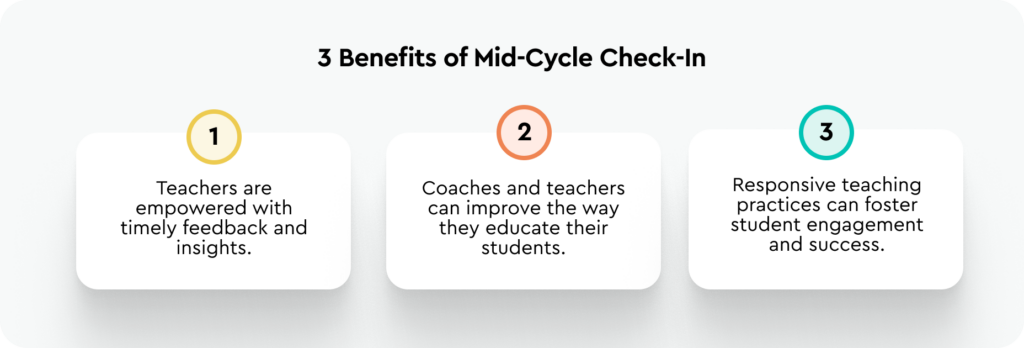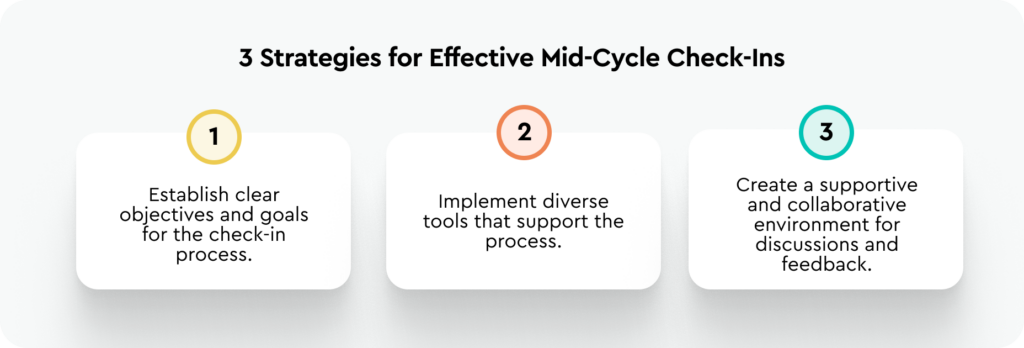Developing your K-12 students is a crucial part of the job. But on top of that, it’s also critical to help your K-12 teachers and coaches continuously develop their own skills and abilities. One great way to support your faculty’s development is through a mid-cycle or mid-school year check-in.
But what makes a mid-year check-in successful? What strategies can you employ to make them impactful, so your students can ultimately benefit as well as your educators? Let’s dive into the purpose and benefits of these check-ins as well as helpful tactics to improve the experience and outcome of your next mid-cycle check-ins with your K-12 teachers and coaches.
What is a mid-cycle check-in?
Mid-cycle check-ins are pivotal moments in the academic calendar where teachers and coaches come together to reflect on the progress made during the first half of the school year. These check-ins serve as checkpoints for professional growth and provide opportunities for valuable feedback, fostering a culture of continuous improvement.
Why are mid-cycle check-ins important?
Regular check-ins and constructive feedback are the cornerstones of effective teaching and learning. By assessing and addressing challenges mid-year, educators can make timely adjustments, ensuring that students receive the best possible education. This iterative process enhances instructional strategies, promotes student engagement, and ultimately contributes to academic success.

Here are the top 3 benefits of a successful mid-cycle check-in:
1. Teachers are empowered with timely feedback and insights.
Mid-cycle check-ins empower teachers by offering them timely feedback on their instructional methods, classroom management, and overall performance. This insight allows educators to refine their teaching strategies, addressing specific challenges and building on successful practices.
2. Coaches and teachers can improve the way they educate their students.
Through the collaborative dialogue initiated during mid-cycle check-ins, educators can identify areas for improvement and explore innovative approaches. This process not only supports individual teachers but also contributes to the overall enhancement of the school’s instructional quality.
3. Responsive teaching practices can foster student engagement and success.
By addressing challenges and refining teaching methods, mid-cycle check-ins contribute to responsive teaching practices. This adaptability fosters a positive and engaging learning environment, directly impacting student success and achievement.
3 Strategies for Effective Mid-Cycle Check-Ins
Holding a successful mid-cycle check-in is easier said than done. It requires careful planning, thoughtful and sometimes empathetic feedback, and should result in concrete and actionable takeaways that give K-12 teachers and coaches a roadmap for improving themselves as well as their educational skills.

These tried-and-true strategies can help guide you towards an effective mid-cycle check-in every time:
1. Establish clear objectives and goals for the check-in process.
Setting clear objectives and goals for mid-cycle check-ins provides a roadmap for the discussion. It ensures that the conversation is focused on actionable steps for improvement rather than vague generalities.
2. Implement diverse tools that support the process.
Utilize a variety of tools, such as self-assessment surveys, classroom observations, and student feedback, to gather comprehensive data. Diverse tools provide a holistic view of the teaching and learning environment, enriching the feedback process.
3. Create a supportive and collaborative environment for discussions and feedback.
A supportive and collaborative environment is crucial for productive mid-cycle check-ins. Fostering open communication, active listening, and a growth mindset creates a space where educators feel comfortable sharing their challenges and successes.
Roles and Responsibilities: Teachers and Coaches
Effective mid-cycle check-ins require a collaborative effort between teachers and coaches. By working together, educators can capitalize on each other’s strengths, address weaknesses, and collectively contribute to a culture of continuous improvement. That being said, it can be helpful for teachers and coaches to each play their own distinct role in the mid-cycle check-in:
- Teachers – Every teacher should play a central role in the check-in process. Actively engaging in reflective conversations, sharing insights into their teaching practices, and being receptive to feedback are essential components of the mid-year check-in experience.
- Coaches – As facilitators of professional growth, coaches play a vital role in guiding mid-cycle check-ins. Providing constructive feedback, identifying resources for improvement, and fostering a collaborative atmosphere are key responsibilities for coaches during these sessions.

Overcoming Challenges in Mid-Cycle Check-Ins
Challenges such as time constraints and workload pressures can impede the successful implementation of mid-cycle check-ins. Recognizing these obstacles is the first step in overcoming them.
Strategies such as effective time management, streamlined processes, and prioritization can help address time constraints and workload challenges. Investing in professional development opportunities focused on efficient feedback practices is also beneficial.
To overcome challenges, it’s essential to cultivate a culture that values feedback and views it as a catalyst for continuous improvement. Celebrate successes, learn from setbacks, and encourage a growth mindset among educators.
Conclusion
Mid-year check-ins are not just a routine checkpoint for K-12 educators; they are a powerful tool for fostering growth, collaboration, and student success. By embracing these check-ins, teachers and coaches embark on a journey of continuous improvement, ensuring that every student receives the best possible education. As we move forward in the academic year, let’s commit to the practice of mid-cycle check-ins, knowing that their long-term impact extends far beyond the classroom — shaping the future of education.












